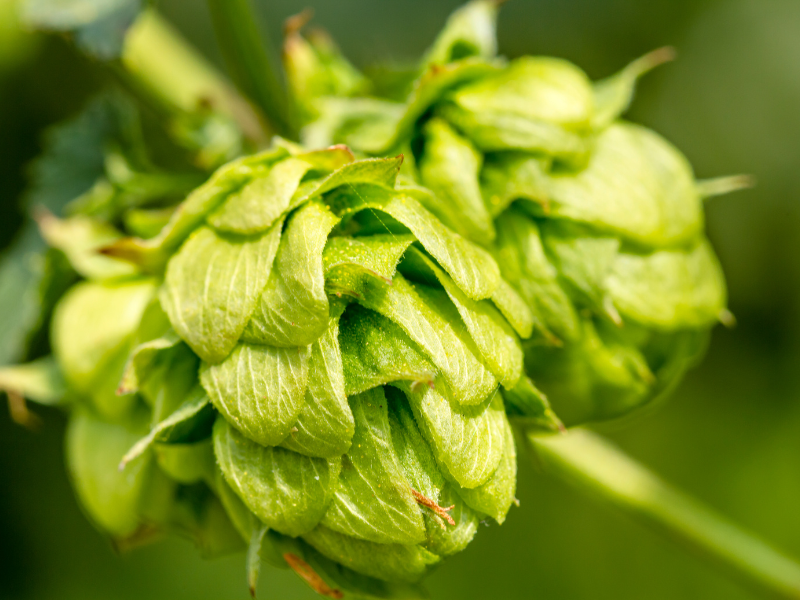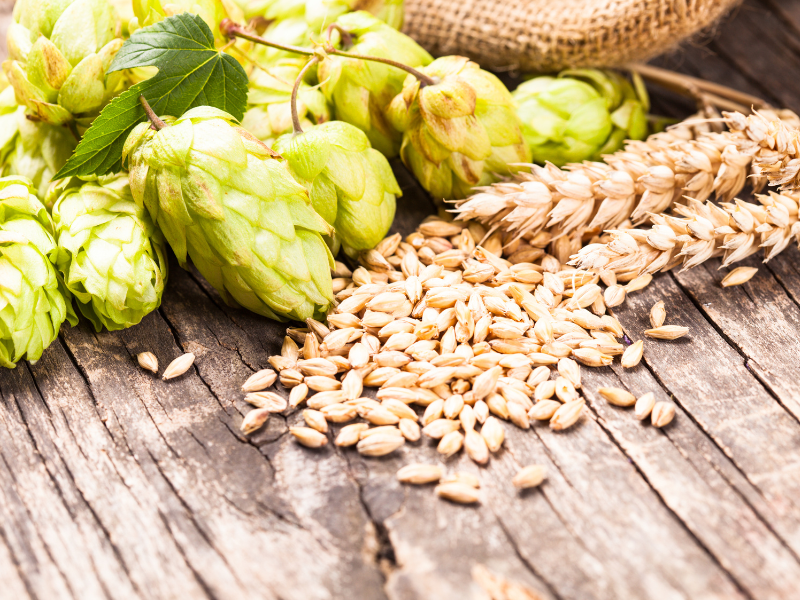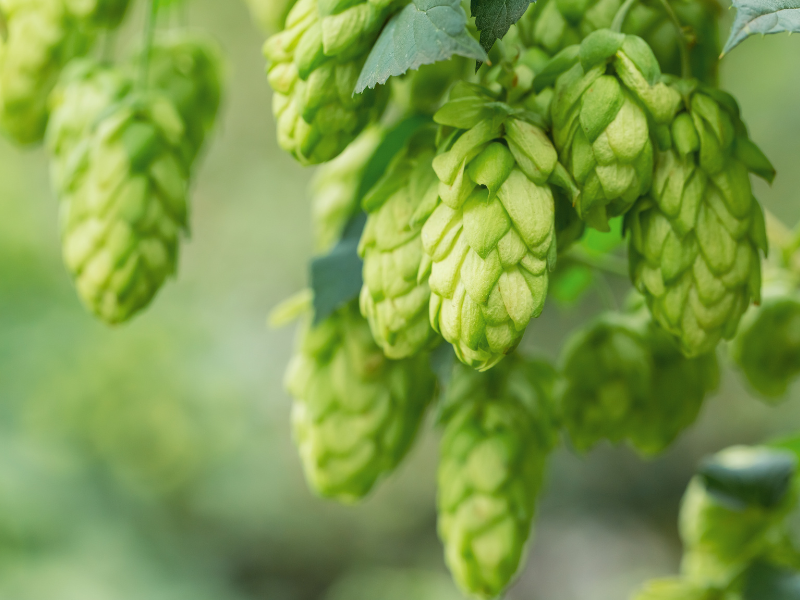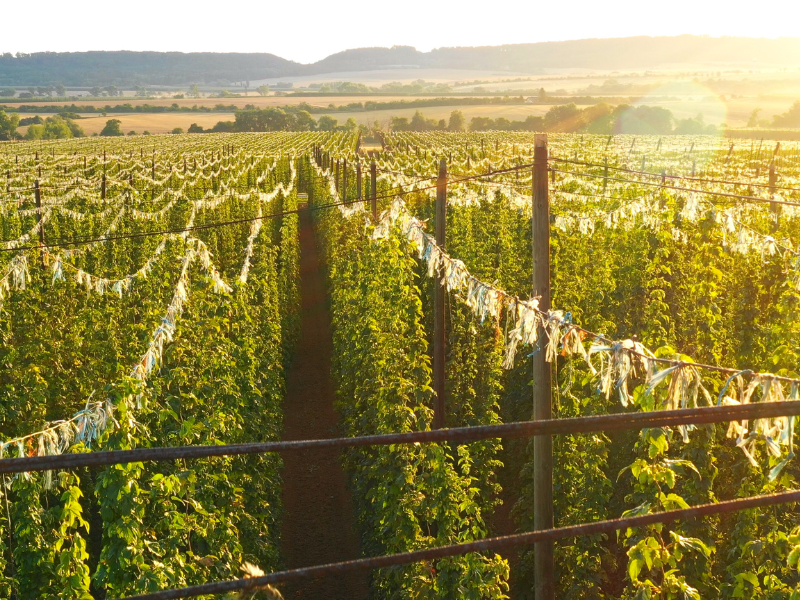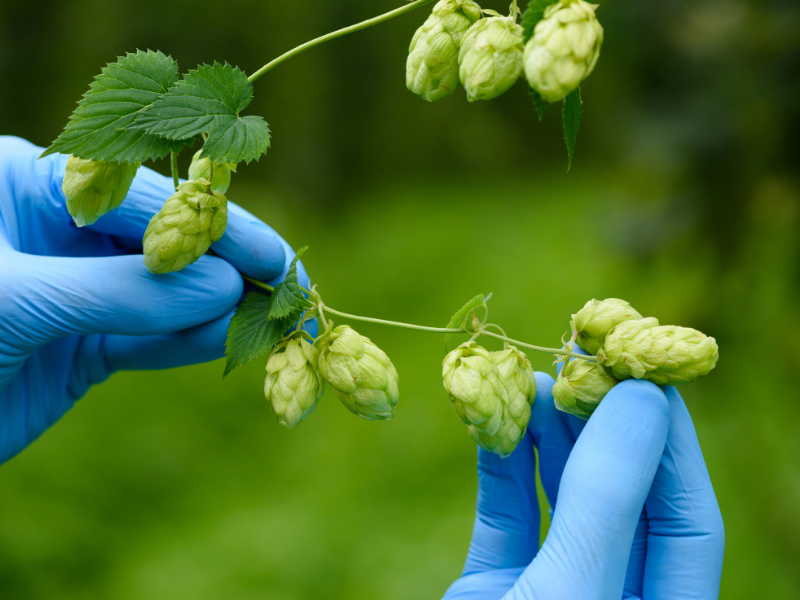It’s no secret that the popularity of craft beers is on the rise. In fact, it’s something better described as an explosion in popularity.
Hops have two purposes in beer production. Hops preserve beer and provide flavor.
All craft beer brewers need to continuously order hops. As the number of craft beer drinkers continues its growth, the need for hops in great variety grows right along with it.
What Exactly is a Hop Farm?
A hop farm is more than just a piece of land—it’s where the magic ingredient behind many of our favorite brews begins its journey. At the heart of it are hops, the aromatic female flowers (or cones) of the Humulus lupulus plant. This isn’t just any plant; it’s a perennial, meaning it grows back year after year, providing a consistent and reliable harvest for farmers.
There’s a dazzling array of hop varieties out there. With hundreds to choose from, each boasts its own distinctive flavor profile. These flavors range from citrusy to earthy, spicy to floral, and everything in between. The variety of hop used can drastically alter the taste of the beer it goes into, making the choice of hop an essential aspect of beer crafting.
The size of a hop farm can vary widely. While some passionate cultivators might start with a modest plot of just two acres, large-scale operations can sprawl over a staggering 100 acres or more. This showcases the immense demand and reverence for this treasured ingredient.
Now, hops aren’t just left to grow wild. They have a natural inclination to climb, reaching soaring heights of 16 to 20 feet. To support this upward growth, farms use structures known as trellises. These are essentially frameworks which give the hop vines the guidance and support they need to grow tall and healthy.
In essence, a hop farm is a blend of nature’s raw beauty and human ingenuity, where age-old traditions meet innovative farming techniques to produce one of beer’s most vital ingredients.
Why You Should Start a Hop Farm Business
The craft beer movement has created a ripple effect, touching not just breweries but also the suppliers of their primary ingredients. If you’re considering starting a hop farm, here are compelling reasons for why now might be the best time:
- Craft Beer’s Rise: The US Brewers Association reports the launch of over 400 new craft breweries annually. This trend isn’t slowing down, especially with Millennials leading the charge in craft beer appreciation.
- Modest Land Requirements:
- Unlike expansive crops like wheat or corn, hops can be cultivated in relatively smaller plots.
- This scalability allows both new entrants and experienced farmers to experiment without the need for vast landholdings.
- Local Sourcing Laws:
- Many states now champion the “local” ethos, with regulations in place that encourage craft brewers to use ingredients grown in their backyard.
- Such laws not only emphasize quality and freshness but also stimulate local economies and foster stronger community ties.
- Supporting Local Economies: By investing in hop farming, you’re also bolstering your local economy. When craft brewers buy local, money stays within the community, promoting sustainable growth.
In essence, the combination of the booming craft beer industry, feasible farming requirements, and a shift towards local sourcing makes the current moment a golden one for potential hop farmers. If you’ve been contemplating this venture, there’s no better time than now to make that leap.
The Hop Industry in the United States
In 1648, colonists established a hops farm to supply a brewery in Massachusetts.
Although that’s the earliest known location of a hop farm in the US, by the 1900s Wisconsin and the Pacific Northwest were the leading producers of hops.
Today Washington leads hops production, commanding 70% of the market. Idaho chips in with 14% and Oregon with 13%. Massachusetts, New York and other states have 4% of the market.
Products You Can Create from Hop Production
Hops and hop farms offer a plethora of product opportunities beyond just the traditional brewing uses. Here’s a list of 10 products that can be produced:
- Craft Beers: The most obvious product, different varieties of hops give beers their unique flavors, aromas, and bitterness profiles.
- Hop Tea: A soothing drink made from steeping dried hop flowers, it’s known for its calming effects and can help with sleep.
- Hop Pillows: Filled with dried hops, these pillows are believed to promote sleep and relaxation due to the plant’s natural sedative qualities.
- Hop Essential Oils: Extracted from the hop flowers, the oil can be used in aromatherapy, perfumes, and even as a natural preservative.
- Hop Tinctures: A concentrated liquid form of hops, these can be taken as dietary supplements to aid sleep or digestion.
- Hop-Infused Lotions and Creams: With anti-inflammatory properties, hop-infused skincare products can help soothe irritated skin.
- Hop-Based Animal Feed: After the brewing process, the spent hops can be used as a component in animal feed, particularly for cattle.
- Hop Compost: Spent hops, being rich in nutrients, can be composted and used to enrich the soil, providing a sustainable way of recycling waste.
- Hop-Infused Foods: From hop-infused chocolates to hop pickles, the unique flavor of hops can be introduced into a variety of gourmet foods.
- Hop Art & Decor: Dried hop vines and flowers can be utilized in decorative wreaths, arrangements, and other craft projects, adding a rustic touch to interiors.
Exploring these diverse products can open up new avenues of revenue for hop farmers, making the most of every part of the plant and its myriad properties.
| Product | Description |
|---|---|
| Craft Beers | Different varieties of hops give beers unique flavors, aromas, and bitterness. |
| Hop Tea | A drink from steeped dried hop flowers known for its calming effects. |
| Hop Pillows | Pillows filled with dried hops that promote sleep and relaxation. |
| Hop Essential Oils | Extracted oil used in aromatherapy, perfumes, and as a natural preservative. |
| Hop Tinctures | Concentrated liquid form taken as dietary supplements for sleep or digestion. |
| Hop-Infused Lotions and Creams | Skincare products with anti-inflammatory properties to soothe irritated skin. |
| Hop-Based Animal Feed | Used spent hops as a component in animal feed, especially for cattle. |
| Hop Compost | Nutrient-rich spent hops used to enrich soil, recycling waste sustainably. |
| Hop-Infused Foods | Foods like chocolates and pickles with the unique hop flavor. |
| Hop Art & Decor | Utilizing dried hop vines/flowers for decorative wreaths and craft projects. |
How to Start a Hop Farm: 12+ Important Steps
- Understanding the Basics of Running a Hop Farm or Hop Yard
- Planting & Training: Successfully cultivating hops hinges on the right planting techniques and “trellis training.” The hops require care and attention, especially during their growing phase.
- Harvest Care: The quality of hops heavily relies on post-harvest treatment. Proper drying, cooling, bailing, and pelletizing processes ensure the hops retain their distinctive properties.
- Gathering Essential Resources for Your Hop Farm
- Trellis Systems: Construct trellises in the off-season to support hops that can shoot up to 20 feet in just six weeks.
- Irrigation: Invest in a drip irrigation system (around $4,000/acre) and overhead sprinklers (approximately $1,000/acre) to ensure optimal moisture.
- Equipment: Harvesting can start by hand, but as production ramps up, consider a hop picker. Plus, you’ll need hop bailers and tractors for efficient operations.
- Diversify by Knowing Your Hop Varieties
- Popular Varieties: Citrus flavors dominate the market, but exploring other unique types can differentiate your yield.
- Specialty Hops: Investigate growing specialty hops like Hallertauer for lagers and ales, or Golding for its mild spice and bittering qualities.
- Ordering and Timing Your Plant Stock Delivery
- When to Plant: Hops are planted in spring, with the most productive growth between years 3-5.
- Choosing Rootstock: Opt for Rhizomes, parts of the root, or Crowns, the whole plant. Rhizomes can be bought in the fall and stored for spring planting.
- Efficiently Planting the Rootstock
- Soil Preparation: Ensure a conducive environment by plowing or tilling your land before planting.
- Planting Techniques: Both Rhizomes and Crowns require manual planting to ensure they establish correctly.
- Nurturing Your Hop Plants
- Watering: Aim for about 30 inches of precipitation throughout the growing season, supplementing with drip irrigation as needed.
- Nutrient & Pest Management: Monitor for pests like Hop aphids and spider mites and manage nutrients by applying the right fertilizer at optimal times.
- Skillful Harvesting Techniques
- The Right Cut: Ensure you cut the hop plant low, letting the vine pass through the hop picker to extract the valuable female flowers.
- Optimal Drying Techniques for Hops
- Moisture Check: Using a moisture meter, ascertain that your hops have a moisture content not less than 6% to avoid mold or quality degradation.
- Outsourcing: If investing in a kiln seems too steep, consider sending your hops to specialized drying facilities.
- Storing Hops the Right Way
- Temperature & Light Control: Store your dried hops in cool, dark places. Cold temperatures help in preserving the aroma and overall hop quality.
- Get Acquainted with the Craft Brewing Process
- Know the Ingredients: Familiarize yourself with the basics, including water, hops, barley (malt), and yeast.
- Understand Brewing: From mashing to fermenting, and finally to filtering and barreling, comprehending this process can enhance your hop selling points.
- Effective Marketing Strategies for Your Hop Business
- Join Associations: Enlist in regional hop growing associations to expand your network.
- Digital Presence: Create an online footprint with a website and active social media. Engage with potential customers through tastings, events, and email campaigns.
- Maximizing Sales and Distribution
- Know Your Competitors: While local is a selling point, remember that major hop producers, especially from the Pacific Northwest, are competitors.
- Sell Direct or Indirect: Use your hops in your brews or sell to other beer makers. Employ online promotions and your digital presence to generate orders.
Bonus Step:
- Continued Learning and Adaptation
- Stay Updated: Agricultural methods, hop varieties, and market demands change. Ensure you stay updated with the latest techniques and trends to remain competitive and innovative in the market.
How Much do Hop Farmers Make?
Hop Growers of America has developed a number of sample budgets for a hop farm of varying size.
Income is affected by two main factors:
- The length of time you’ve been in business. Profits are eaten up the first year or two by the cost of capital investment, and the length of time it takes for hop plants to mature (3 years).
- The size in acreage of your farm.
Hop Growers of America has all the questions answered for newcomers. Basically, hops sell at from $3-15 per pound. When plants are mature, the yield can be 1,800 pounds per acre.
Most craft breweries contract for 90% of the hops they use. It can be hard for newcomers to edge in on long-established contracts.
Things to Consider Before Starting a Hop Business
- Understanding the Nature of Hops
- Growth Cycle: Hops require a 120-day growing season, thriving best in USDA hardiness zones 3-8. After harvesting, the roots remain in the soil. Take note that if temperatures plummet below -20°F, the plant’s survival is threatened.
- Site Selection for Optimal Growth
- Soil Quality: Favor regions with fertile, well-draining soil.
- Sunlight: Ensure the chosen location gets a daily sun exposure of 6-8 hours, essential for healthy hop growth.
- Climate and Environmental Considerations
- Soil pH Level: Aim for a soil pH range between 6-7.5.
- Ideal Climate: A climate characterized by hot, humid summers is ideal. This is one reason the Pacific Northwest is a predominant hub for hop farming.
- Navigating Environmental Regulations
- Varied Permits: Acquire relevant environmental permits, which can differ state-by-state.
- Special Licensing: States like New York mandate specific licenses for hop farming. Familiarize yourself with regional requirements.
- Identifying Your Target Market
- Understanding Contracts: Recognize that established hop growers often have long-term contracts in place, aligning with the plant’s peak production years.
- Market Research: Delve into potential buyer-producer relationships. Engage with local associations for industry insights.
- Know Your Customers: Pinpoint who your primary customers will be. Are they craft brewers, food manufacturers, or home brewing enthusiasts?
- Labor and Workforce Management
- Seasonal vs. Permanent: While certain tasks, like planting and trellis training, demand seasonal help, there’s a need for full-time staff for consistent monitoring against pests, fungal diseases, and ensuring apt irrigation.
- Insuring Your Business with Proper Coverage
- Specialized Insurance: As with any agricultural business, opt for crop insurance to safeguard against unforeseen crop losses. Furthermore, consider comprehensive coverage for farm infrastructure, machinery, and vehicles.
- Managing Taxes Efficiently
- Employee Identification Number (EIN): If you’re looking to hire, an EIN is essential.
- Tax Estimation and Payments: Given the seasonal nature of hop farming income—primarily concentrated around the harvest period—it’s pivotal to estimate taxes and make quarterly payments to avoid financial hiccups.
By giving due consideration to each of these aspects, you’ll be better positioned to kickstart a prosperous hop farming enterprise.
How much does it cost to start growing hops?
The estimate for start-up costs is $200,000 for 10 acres.
How much is an acre of hops worth?
The value of an acre of hops varies depending on several factors, including the hop variety, location, market demand, and the yield per acre. As of my last training data up to 2021, the average U.S. hop farm could expect a yield of around 1,700 to 2,500 pounds per acre for mature plants, depending on variety and growing conditions.
In terms of pricing, hops sold for anywhere between $3 to $20 per pound, depending on the variety and contract specifics. Using an average price of $10 per pound for a mid-range variety and an average yield of 2,000 pounds per acre, one acre of hops could be worth about $20,000. However, this is a rough estimation.
It’s essential to consider expenses like planting, cultivation, harvest, processing, and marketing, which can significantly affect the net income from that acre. Additionally, market conditions and demand for specific hop varieties can cause prices to fluctuate year-to-year.
For the most accurate and up-to-date information, prospective hop farmers should consult local agricultural extensions or hop grower associations in their region.
How many acres of hops are profitable?
Even if you sell $18,000 worth for one acre, you may net only $1,000 per acre your first year.
That’s due to the costs of the trellis system and other farm machinery. Also, your plants have not matured to their top producing capabilities when harvesting at one or two years old.
The more acres, the more trellises you need. But the equipment needs don’t change.
How many acres do you need to grow hops?
According to a 2020 Cornell study, the cost per acre to get established is $12,000-15,000 per acre.
According to the same study, 10-15 acres should yield $12,000-15,000 per acre income.
Once you’re established with equipment, the variations in profit are connected to the age of the plant. Keeping the farm in peak production mode requires planning.
Image: Depositphotos
This article, “How to Start a Hop Farm” was first published on Small Business Trends
